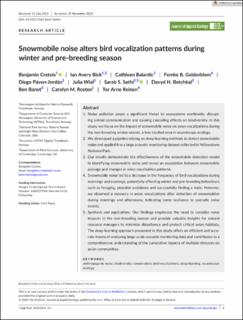| dc.contributor.author | Cretois, Benjamin | |
| dc.contributor.author | Bick, Ian Avery | |
| dc.contributor.author | Balantic, Cathleen | |
| dc.contributor.author | Gelderblom, Femke Berre | |
| dc.contributor.author | Pavòn-Jordàn, Diego | |
| dc.contributor.author | Wiel, Julia | |
| dc.contributor.author | Sethi, Sarab Singh | |
| dc.contributor.author | Betchkal, David H. | |
| dc.contributor.author | Banet, Ben | |
| dc.contributor.author | Rosten, Carolyn | |
| dc.contributor.author | Reinen, Tor Arne | |
| dc.coverage.spatial | Yellowstone National Park | en_US |
| dc.date.accessioned | 2023-12-19T11:03:41Z | |
| dc.date.available | 2023-12-19T11:03:41Z | |
| dc.date.created | 2023-12-18T12:36:48Z | |
| dc.date.issued | 2023 | |
| dc.identifier.issn | 0021-8901 | |
| dc.identifier.uri | https://hdl.handle.net/11250/3108178 | |
| dc.description.abstract | Noise pollution poses a significant threat to ecosystems worldwide, disrupting animal communication and causing cascading effects on biodiversity. In this study, we focus on the impact of snowmobile noise on avian vocalizations during the non-breeding winter season, a less-studied area in soundscape ecology. We developed a pipeline relying on deep learning methods to detect snowmobile noise and applied it to a large acoustic monitoring dataset collected in Yellowstone National Park. Our results demonstrate the effectiveness of the snowmobile detection model in identifying snowmobile noise and reveal an association between snowmobile passage and changes in avian vocalization patterns. Snowmobile noise led to a decrease in the frequency of bird vocalizations during mornings and evenings, potentially affecting winter and pre-breeding behaviours such as foraging, predator avoidance and successfully finding a mate. However, we observed a recovery in avian vocalizations after detection of snowmobiles during mornings and afternoons, indicating some resilience to sporadic noise events. Synthesis and applications: Our findings emphasize the need to consider noise impacts in the non-breeding season and provide valuable insights for natural resource managers to minimize disturbance and protect critical avian habitats. The deep learning approach presented in this study offers an efficient and accurate means of analysing large-scale acoustic monitoring data and contributes to a comprehensive understanding of the cumulative impacts of multiple stressors on avian communities. | en_US |
| dc.description.abstract | Snowmobile noise alters bird vocalization patterns during winter and pre-breeding season | en_US |
| dc.language.iso | eng | en_US |
| dc.rights | Navngivelse 4.0 Internasjonal | * |
| dc.rights.uri | http://creativecommons.org/licenses/by/4.0/deed.no | * |
| dc.subject | anthropogenic noise | en_US |
| dc.subject | biodiversity conservation | en_US |
| dc.subject | bird vocalizations | en_US |
| dc.subject | deep learning | en_US |
| dc.subject | soundscape ecology | en_US |
| dc.title | Snowmobile noise alters bird vocalization patterns during winter and pre-breeding season | en_US |
| dc.title.alternative | Snowmobile noise alters bird vocalization patterns during winter and pre-breeding season | en_US |
| dc.type | Peer reviewed | en_US |
| dc.type | Journal article | en_US |
| dc.description.version | publishedVersion | en_US |
| dc.rights.holder | © 2023 The Authors | en_US |
| dc.subject.nsi | VDP::Matematikk og Naturvitenskap: 400::Zoologiske og botaniske fag: 480 | en_US |
| dc.source.journal | Journal of Applied Ecology | en_US |
| dc.identifier.doi | 10.1111/1365-2664.14564 | |
| dc.identifier.cristin | 2214825 | |
| dc.relation.project | Norges forskningsråd: 160022 | en_US |
| cristin.ispublished | true | |
| cristin.fulltext | original | |
| cristin.qualitycode | 2 | |

